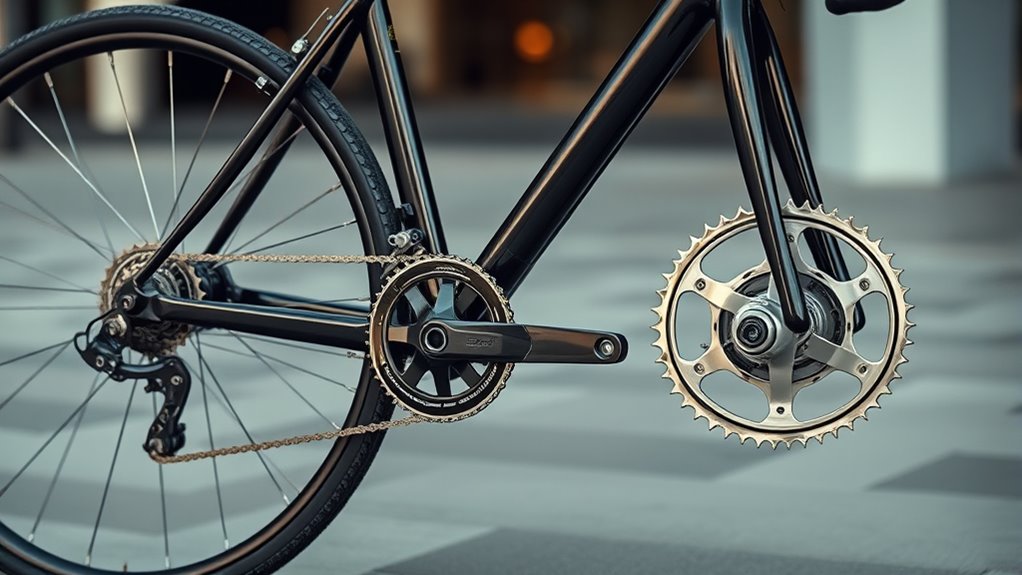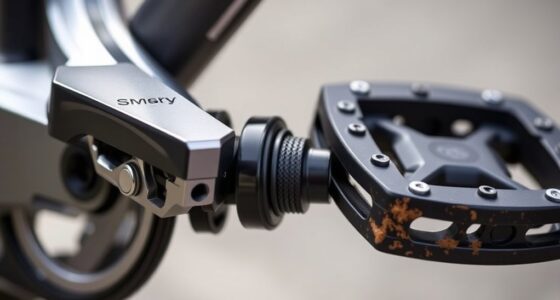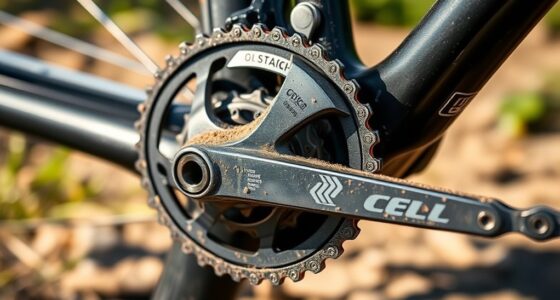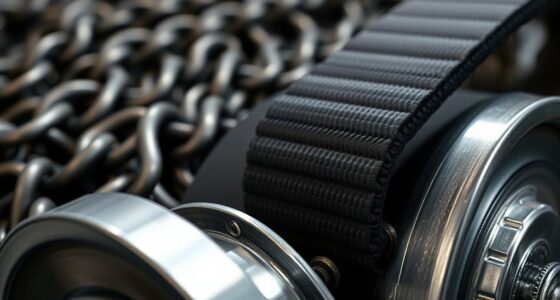Choosing between a 1x and 2x drivetrain boils down to your riding style and maintenance preferences. A 1x offers simpler operation, fewer parts, and less upkeep, making it ideal for straightforward, hassle-free riding. In contrast, a 2x provides a wider, more precise gear range, which benefits those tackling diverse terrains but requires more regular tuning and cleaning. To discover which setup suits your needs best, explore the key trade-offs involved.
Key Takeaways
- 1x offers simpler, low-maintenance setup with fewer components and easier cleaning, ideal for casual or all-condition riding.
- 2x provides a wider, more precise gear range, suitable for challenging terrains requiring fine-tuned cadence and power control.
- 1x reduces the risk of chain drops and mis-shifting, simplifying operation and decreasing repair needs.
- 2x requires managing two shifters and regular adjustments of front derailleur, demanding more maintenance effort.
- Choice depends on rider preference: 1x favors simplicity and durability, while 2x offers versatility at the cost of increased upkeep.
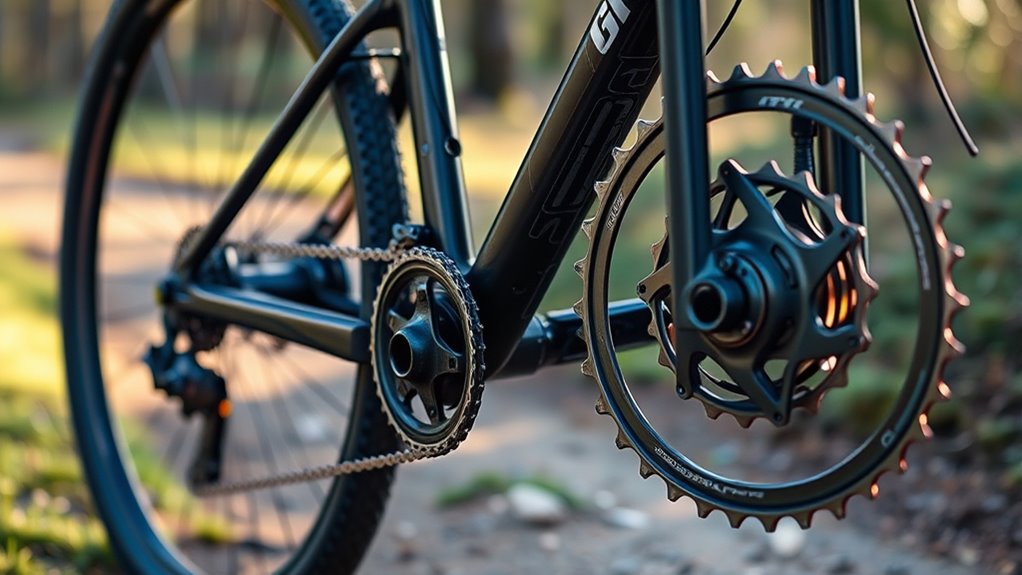
When choosing between 1x and 2x drivetrains, understanding their differences can help you make an informed decision. One of the key factors to consider is gear ratios. With a 1x drivetrain, you get a single chainring up front, which means fewer gear options but a simplified setup. The gear ratios are designed to cover a broad range, allowing you to handle most terrains without the need for multiple chainrings. This makes shifting more straightforward, as you only need to focus on a single shifter, reducing the chances of mis-shifting or dropping chains. On the other hand, a 2x drivetrain offers two chainrings at the front, providing a wider and more granular range of gear ratios. This setup lets you fine-tune your cadence and power output, especially on challenging climbs or high-speed descents. However, it also introduces additional complexity, as you need to manage two shifters and ensure proper gear indexing.
When it comes to maintenance ease, a 1x drivetrain generally wins out. Since it has fewer components—no front derailleur or multiple chainrings—you spend less time adjusting and cleaning. The single chainring reduces the risk of chain drops and the need for precise front shifting adjustments, making it more reliable and easier to maintain. Cleaning is also simpler because there are fewer parts to get gunked up with dirt and debris. Conversely, a 2x system demands more attention. The front derailleur, multiple chainrings, and extra cables require regular adjustments to keep shifting smooth. Dirt and grime can accumulate in the front derailleur and between chainrings, necessitating more frequent cleaning and tuning. Over time, these components are more prone to wear, which means you’ll need to replace parts more often and invest additional effort in upkeep. Additionally, vetted reviews can help you assess the real-world performance and durability of each system.
Ultimately, your choice depends on your riding style and maintenance preferences. If you prefer a straightforward, low-maintenance setup that functions reliably with minimal fuss, a 1x drivetrain is a solid choice. If you value a wider gear range for varied terrain and don’t mind the extra upkeep, a 2x drivetrain may suit you better. Both systems have their strengths, but understanding gear ratios and maintenance ease helps you weigh the trade-offs effectively, ensuring you pick the drivetrain that aligns with your riding needs and maintenance expectations.
Frequently Asked Questions
How Does Drivetrain Choice Affect Bike Weight?
Your drivetrain choice impacts bike weight because 2x systems typically add extra components like front derailleurs and shifters, increasing overall weight. They offer more gear ratios, which can improve efficiency, but at the cost of added weight and complexity. Conversely, 1x setups are lighter since they lack those extra parts, and they often feature better chain retention, reducing weight even further while simplifying maintenance.
Are 2x Drivetrains More Durable Than 1x?
They say, “An ounce of prevention is worth a pound of cure.” When it comes to gear ratios and chain durability, 2x drivetrains tend to be more durable because they spread out wear across more components, reducing stress on individual parts. However, with proper maintenance, 1x drivetrains can also last long. Ultimately, your riding style and maintenance habits determine which drivetrain holds up better over time.
Can I Switch From 1x to 2x Easily?
Yes, you can switch from 1x to 2x, but it depends on your bike’s gear compatibility and shifting complexity. You’ll need to verify your derailleur, shifters, and cassette are compatible with a double chainring setup. The process involves installing a new front derailleur, shifters, and possibly changing the crankset. Keep in mind, shifting complexity increases with 2x, so be prepared for a bit more tuning and adjustment.
What Maintenance Differences Exist Between 1x and 2x?
You’ll find that 2x drivetrains require more maintenance, with about 20% more frequent adjustments. You need to regularly check and lubricate the chain and ensure gear alignment, especially since 2x systems have more moving parts. In contrast, 1x drivetrains are simpler, needing less frequent chain lubrication and gear adjustments. Staying attentive to these maintenance tasks keeps your bike running smoothly and prolongs component life.
Which Drivetrain Is Better for Climbing?
You’ll find the 2x drivetrain better for climbing because it offers a wider range of gear ratios through different chainring sizes. This allows you to select a smaller chainring for steep hills, making pedaling easier. In contrast, 1x drivetrains have limited gear options but simplify shifting. If climbing is your priority, a 2x setup provides more precise gearing, helping you maintain a comfortable cadence on varied terrain.
Conclusion
Choosing between 1x and 2x drivetrains is like picking the right tool for your ride’s journey. Think of 1x as a simple, steady stream—less clutter, easy to manage. Meanwhile, 2x offers a wider range, like a mountain stream rushing through varied terrain. Your decision shapes your ride’s adventure. Trust your riding style, and remember, the right drivetrain will be your faithful compass, guiding you smoothly through every twist and turn on your path.
